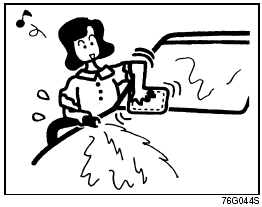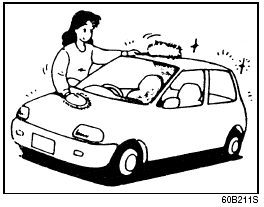Vehicle Cleaning


WARNING:
When cleaning the interior or exterior
of the vehicle, NEVER USE flammable
solvents such lacquer thinners, gasoline,
benzene or cleaning materials
such as bleaches and strong household
detergents. The materials could
cause personal injury or damage to
the vehicle.
Cleaning Interior
Vinyl upholstery
Prepare a solution of soap or mild detergent mixed with warm water. Apply the solution to the vinyl with a sponge or soft cloth and let it soak for a few minutes to loosen dirt. Rub the surface with a clean, damp cloth to remove dirt and the soap solution. If some dirt still remains on the surface, repeat this procedure.
Fabric upholstery
Remove loose dirt with a vacuum cleaner.
Using a mild soap solution, rub stained areas with a clean damp cloth. To remove soap, rub the areas again with a cloth dampened with water. Repeat this until the stain is removed, or use a commercial fabric cleaner for tougher stains. If you use a fabric cleaner, carefully follow the manufacturer’s instructions and precautions.
Leather upholstery
Remove loose dirt with a vacuum cleaner.
Using a mild soap or saddle soap solution, wipe dirt off with a clean damp soft cloth.
To remove soap, wipe the areas again with a soft cloth dampened with water. Wipe the areas dry with a soft dry cloth. Repeat this until the dirt or stain is removed, or use a commercial leather cleaner for tougher dirt or stains. If you use a leather cleaner, carefully follow the manufacture’s instructions and precautions. Do not use solvent type cleaners or abrasive cleaners.
Seat belts
Clean seat belts with a mild soap and water. Do not use bleach or dye on the belts. They may weaken the fabric in the belts.
Vinyl floor mats
Ordinary dirt can be removed from vinyl with water or mild soap. Use a brush to help loosen dirt. After dirt is loosened, rinse the mat thoroughly with water and dry it in the shade.
Carpets
Remove dirt and soil as much as possible with a vacuum cleaner. Using a mild soap solution, rub stained areas with a clean damp cloth. To remove soap, rub the areas again with a cloth dampened with water.
Repeat this until the stain is removed, or use a commercial carpet cleaner for tougher stains. If you use a carpet cleaner, carefully follow the manufacturer’s instructions and precautions.
Cleaning the Exterior
CAUTION:
It is important that your vehicle be
kept clean and free from dirt. Failure
to keep your vehicle clean may result
in fading of the paint or corrosion to
various parts of the vehicle body.
Washing

WARNING:
• Never attempt to wash and wax
your vehicle with the engine running.
• When cleaning the underside of the body and fender, where there may be sharp-edged parts, you should wear gloves and a long-sleeved shirt to protect your hands and arms from being cut.
• After washing your vehicle, carefully test the brakes before driving to make sure they have maintained their normal effectiveness.
When washing the vehicle, follow the
instructions below:
1) Flush the underside of body and wheel
housings with pressurized water to
remove mud and debris. Use plenty of
water.
CAUTION:
• When washing the vehicle, avoid
directing steam or hot water of
more than 80°C (176°F) on plastic
parts.
• To avoid damaging engine components,
do not use pressurized
water in the engine compartment.
2) Rinse the body to loosen the dirt.
Remove dirt and mud from the body exterior with running water. You may use a soft sponge or brush. Do not use hard materials which can scratch the paint or plastic. Remember that the headlight covers or lenses are made of plastic in many cases.
CAUTION:
To avoid damage to the paint or plastic
surface, do not wipe the dirt off
without ample water. Be sure to follow
above procedure.
3) Wash the entire exterior with a mild detergent or car wash soap using a sponge or soft cloth. The sponge or cloth should be frequently soaked in the soap solution.
CAUTION:
When using a commercial car wash
product, observe the cautions specified
by the manufacturer. Never use
strong household detergents or
soaps.
4) Once the dirt has been completely removed, rinse off the detergent with running water.
5) After rinsing, wipe off the vehicle body with a wet chamois or cloth and allow it to dry in the shade.
6) Check carefully for damage to painted
surfaces. If there is any damage,
“touch-up” the damage following the
procedure below:
1. Clean all damaged spots and allow
them to dry.
2. Stir the paint and “touch-up” the damaged spots lightly using a small brush.
3. Allow the paint to dry completely.
CAUTION:
If you use an automatic car wash,
make sure that your vehicle’s body
parts, such as spoilers, can not be
damaged. If you are in doubt, consult
the car wash operator for advice.

Waxing
After washing the vehicle, waxing and polishing are recommended to further protect and beautify the paint.
• Only use waxes and polishes of good quality.
• When using waxes and polishes, observe the precautions specified by the manufacturers.
See also:
Service Station Guide
1. Fuel.
2. Engine hood.
3. Tire changing tools.
4. Engine oil dipstick <Yellow>.
5. Automatic transaxle fluid dipstick <Red>.
6. Engine coolant.
7. Windshield washer fluid.
8. Ba ...
Tire Changing Tool
Tire Changing Tool
The jack, wheel brace and jack handle are
stowed in the rear left corner of the luggage
compartment. Remove the cover to
access the tools.
To remove the jack, turn its shaft ...
2009 Suzuki Equator review By G. Chambers Williams III
The obvious question is why Suzuki added a midsize pickup for 2009 when
trucks are losing favor.
"Why not?" responds an unapologetic Gene Brown, Suzuki's vice president of
marketing.
...
